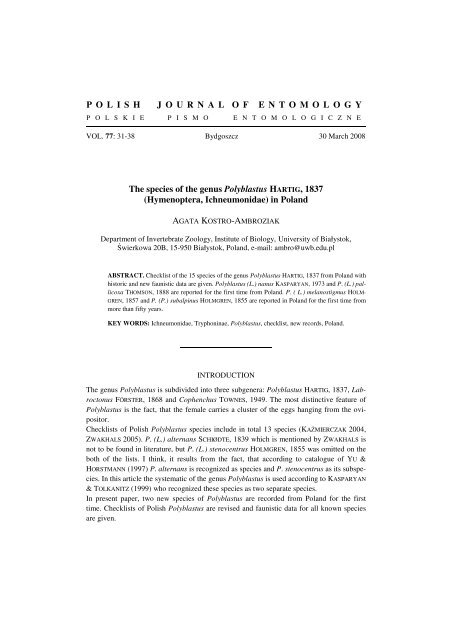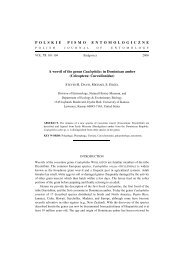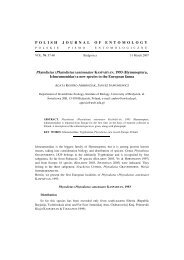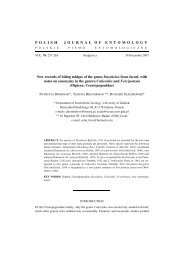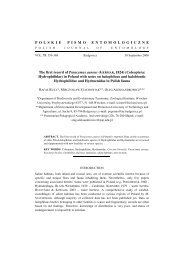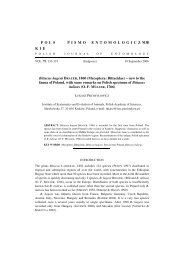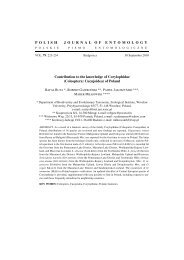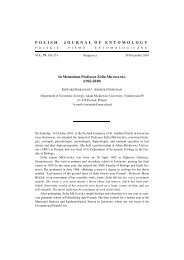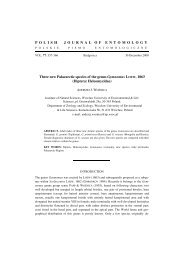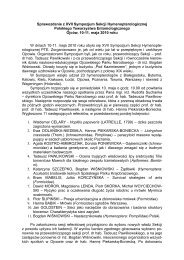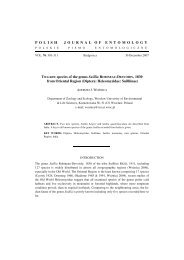Hymenoptera, Ichneumonidae
Hymenoptera, Ichneumonidae
Hymenoptera, Ichneumonidae
You also want an ePaper? Increase the reach of your titles
YUMPU automatically turns print PDFs into web optimized ePapers that Google loves.
P O L I S H J O U R N A L O F E N T O M O L O G YP O L S K I E P I S M O E N T O M O L O G I C Z N EVOL. 77: 31-38 Bydgoszcz 30 March 2008The species of the genus Polyblastus HARTIG, 1837(<strong>Hymenoptera</strong>, <strong>Ichneumonidae</strong>) in PolandAGATA KOSTRO-AMBROZIAKDepartment of Invertebrate Zoology, Institute of Biology, University of Białystok,Świerkowa 20B, 15-950 Białystok, Poland, e-mail: ambro@uwb.edu.plABSTRACT. Checklist of the 15 species of the genus Polyblastus HARTIG, 1837 from Poland withhistoric and new faunistic data are given. Polyblastus (L.) nanus KASPARYAN, 1973 and P. (L.) pallicoxaTHOMSON, 1888 are reported for the first time from Poland. P. ( L.) melanostigmus HOLM-GREN, 1857 and P. (P.) subalpinus HOLMGREN, 1855 are reported in Poland for the first time frommore than fifty years.KEY WORDS: <strong>Ichneumonidae</strong>, Tryphoninae, Polyblastus, checklist, new records, Poland.INTRODUCTIONThe genus Polyblastus is subdivided into three subgenera: Polyblastus HARTIG, 1837, LabroctonusFÖRSTER, 1868 and Cophenchus TOWNES, 1949. The most distinctive feature ofPolyblastus is the fact, that the female carries a cluster of the eggs hanging from the ovipositor.Checklists of Polish Polyblastus species include in total 13 species (KAŹMIERCZAK 2004,ZWAKHALS 2005). P. (L.) alternans SCHIØDTE, 1839 which is mentioned by ZWAKHALS isnot to be found in literature, but P. (L.) stenocentrus HOLMGREN, 1855 was omitted on theboth of the lists. I think, it results from the fact, that according to catalogue of YU &HORSTMANN (1997) P. alternans is recognized as species and P. stenocentrus as its subspecies.In this article the systematic of the genus Polyblastus is used according to KASPARYAN& TOLKANITZ (1999) who recognized these species as two separate species.In present paper, two new species of Polyblastus are recorded from Poland for the firsttime. Checklists of Polish Polyblastus are revised and faunistic data for all known speciesare given.
32 Polish Journal of Entomology 77 (1)AcknowledgmentsI am grateful to J. SAWONIEWICZ and M. ŁUSZCZAK, for providing the materials forstudy. H. PIEKARSKA-BONIECKA made comments to the manuscript.SYSTEMATIC REVIEWPolyblastus (Polyblastus) cancer HARTIG, 1837( = palaemon SCHIØDTE, 1838; = pyramidatus HOLGREN, 1855)The species has so far been known only from south-western Poland: Wrocław(Osobowice) (XS36), Grabice (XR68) (HEDWIG 1940); the Western Beskidy Mountains,Kurnikówka (KAŹMIERCZAK 1993); the Pieniny Mountains (SAWONIEWICZ 1976).Polyblastus (Polyblastus) clypearis BRISCHKE, 1891The existence of this species is uncertain. It has been known hitherto only from Polandand only with one record (BRISCHKE 1891).Polyblastus (Polyblastus) cothurnatus GRAVENHORST, 1829Material examinedThe Biebrza National Park: Gugny (FE01), 27.08.1983, 1 ♀; Stójka (FE01),11.08.1983, 1 ♀; Osowiec Twierdza (FE02), 30.06.2007, 1 ♀. The Budzisk Reserve(FE50), 12.07.2005, 1 ♀.Apart from above records this species has been found also in Podkowa Leśna (DC87)(GŁOWACKI 1953); Wrocław-Osobowice (XS36), Miękinia (XS27), Kalinowice (XS41),Kamienna Góra (WS72), Cieplice Śląskie-Zdrój (WS43), Janowice Wielkie (WS63)(HEDWIG 1940); Warsaw (DC99) (SAWONIEWICZ 1981); the Tuchola Forest (SAWONIEWICZ1999).Polyblastus (Cophenchus) macrocentrus THOMSON, 1888Material examinedBiałystok (Instytut of Biology), 27.07.2005, 1 ♀. Mielnik, the Głogi Reserve,10.06.2006, 1 ♀. Rogów ad Koluszki, 27.5.1995, 2 ♀♀. The Świętokrzyski National Park:12.05.1994, 2 ♀♀; 7.06.1994, 2 ♀♀.
KOSTRO-AMBROZIAK A.: The species of the genus Polyblastus 33The species previously has been known only from Warsaw (DC99, DC98) (SA-WONIEWICZ 1981, 1982, 1986).Polyblastus ( Labroctonus) melanostigmus HOLMGREN, 1857(= grammicus HOLMGREN, 1857)Material examinedThe Biebrza National Park, Gugny (FE01), 8.06.2006, 2 ♀♀.It is the first record of this species in Poland from more than sixty years. It has beenpreviously known only from Lower Silesia (HEDWIG 1940).Polyblastus (Labroctonus) nanus KASPARYAN, 1973Material examinedThe Kampinos National Park, Łomna (DD80), 20.09.1985, 1 ♀ (Fig. 1) .A new ichneumonid for Polish fauna. This Palearctic species has been reported to occurfrom Sweden and Finland to Kamchatka. It differs from other species of the subgenusLabroctonus by having white eggs carried by the female.Polyblastus (Labroctonus) pallicoxa THOMSON, 1888Material examinedThe Biebrza National Park, Grobla Honczarowska (FE01), 11.08.2006, 1 ♀ (Fig. 1) .A new ichneumonid for Polish fauna. The species is widespread in Palearctic. It differsfrom close P. melanostigmus and P. stenocentrus by having fore and middle coxae, trochantersand most part of its hind tibiae white.Polyblastus (Polyblastus) pinguis GRAVENHORST, 1820In Poland this species has been known only from Wrocław (Szczytniki, Sołtysowice(XS46), Osobowice (XS36)) and Cesarzowice (XS35) (HEDWIG 1940).Polyblastus (Labroctonus) pumilus HOLMGREN, 1855Material examinedThe Biebrza National Park, Grobla Honczarowska (FE01), 3.08.2005, 1 ♀.The species has been recorded by HEDWIG (1940) from Lower Silesia, but as synonymof P. (L.) stenocentrus HOLMGREN, 1855. According to KASPARYAN & TOLKANITZ (1999)
34 Polish Journal of Entomology 77 (1)pumilus and stenocentrus are recognized as two separate species. Unfortunately, it is impossibleto verify detection of this specimen.Fig. 1. The localities of Polyblastus (L.) nanus KASPARYAN, 1973 (▲) and P. (L.) pallicoxa THO-MSON, 1888 (●) in Poland.Polyblastus (Labroctonus) stenocentrus HOLMGREN, 1855Material examinedThe Świętokrzyski National Park, 7.06.1994, 1 ♀. Rogów (DC24), 2 ♀♀.The species has been recorded from Lower Silesia (TORKA 1931, HEDWIG 1940) andOstróda (DE35) (GÓRNY 1979). It was omitted on preexisting checklists of the Polishfauna.Polyblastus (Polyblastus) subalpinus HOLMGREN, 1855(= pedalis CRESSON, 1864; = carbonator KASPARYAN, 1970)
KOSTRO-AMBROZIAK A.: The species of the genus Polyblastus 35Material examinedThe Kampinos National Park, Łomna (DD80), 6.06.1987, 1 ♀. Krynica (DV97),9.06.1997, 1 ♀.In Poland, it is the first record of this species from more than fifty years. It has beenpreviously known only from Lower Silesia (HEDWIG 1943).Polyblastus (Polyblastus) tener HABERMEHL, 1909Material examinedThe Białowieża Forest, Topiło (FD73), 26.05.1986, 1 ♀. The Borecka Forest , 13-27.07.1995, 1 ♀. Kopciowa (DV97), 26.06.2001, 1 ♀. Krynica (DV97), 29.07.1986, 1 ♀.the Mochnaczka Lowland (EV07): 9.08.2005, 2 ♀♀; 6.09.2005, 2 ♀♀; 3.07.2005, 3 ♀♀.Stulno ad Włodawa (FB89), 22.07.2006, 1 ♀.The species has so far been known only from a few localities of south-western Poland:Kolonia Stara Bystrzyca (XR17), Wrocław (Sobótka) (XS23), Jelcz (XS65), Stronie Śląskie(XR37), Gajnik (XR26) (HEDWIG 1940); Andrychów (CA82), Kurnikówka (KAŹMIERCZAK1993); the Pieniny National Park (KAŹMIERCZAKOWA et al. 1997).Polyblastus (Polyblastus) varitarsus (GRAVENHORST, 1829)(= strobilator THUNBERG, 1822; = subtilis THOMSON, 1883)Material examinedThe Biebrza National Park: Gugny (FE01), (31.08.1983, 2 ♀♀; 21.05.1983, 1 ♀;30.06.1985, 1 ♀; 30.08.1983, 1 ♀; 20.09.1982, 1 ♀; 14.07.1983, 1 ♀; 8.08.1982, 1 ♀; 09.1983, 1 ♀; 11.08.2005, 3 ♀♀; 22.6.2006, 6 ♀♀; 06.07.2005, 3 ♀♀; 08.07.2006, 1 ♀;17.08.2006, 1 ♀); mineral elevation Pogorzały (FE01), (8.07.2006, 2 ♀♀; 22.06.2006,3 ♀♀; 14.07.2006, 1 ♀; 29.07.2006, 3 ♀♀); Grobla Honczarowska (FE01), (3.06.1983,1 ♀; 25.08.1983, 1 ♀; 11.08.2006, 2 ♀♀; 29.08.2006, 1 ♀; 5.10.2005, 2 ♀♀); Stójka(FE01), (22.06.2006, 1 ♀; 22.06.1983, 1 ♀; 4.07.1983, 1 ♀; 4.10.1982, 2 ♀♀; 22.08.1983,1 ♀; 11.08.1983, 1 ♀); Sośnia (FE02), 28.09.2005, 1 ♀; Werykle (FE01), (29.05.1093, 1 ♀;14.06.1983, 1 ♀; 6.07.1983, 1 ♀); Chojnowo (FE01), 2.09.2006, 1 ♀; Lisie Nory (FE01),(27.05.1983, 1 ♀; 24.07.1982, 1 ♀); Koźli Rynek (EF01), (25.08.1983, 1 ♀; 21.09.1983,5 ♀♀; 31.08.1983, 1 ♀; 1.10.1982, 2 ♀♀); Dobarz (EF01), 20.07.1982, 2 ♀♀. The BoreckaForest, Lipowa Góra, 24.07.1985, 1 ♀. The Kampinos National Park, Łomna (DD80),20.09.1995, 1 ♀. Kopciowa (DV97), 1 ♀. Kostry-Litwa (FD15), 01.11.2004, 1 ♀. Krasne(FD59), 1.06.2005, 1 ♀. Krynica (DV97): 18.06.2004, 1 ♀; 9.06.1997, 1 ♀; 25.06.1991,1 ♀; 15.07.1994, 1 ♀; 21.07.1998, 1 ♀. Łoboda (CE15), 21.07.1986, 1 ♀. The RoztoczańskiNational Park, the Mędzyrzecz Reserve, 05.07.2006, 1 ♀. Stulno (FB89), 22.07.2006,2 ♀♀.
36 Polish Journal of Entomology 77 (1)Apart from above records, this species has been recorded in Poland from some scatteredlocalities: Wrocław (Szczytniki (XS46), Sobótka (XS23)), Jelcz (XS65), Miękinia(XS27), Cieplice Śląskie-Zdrój (WS43) (HEDWIG 1940); Kurnikówka, Modohora (CA81)(KAŹMIERCZAK 1993); the Biebrza National Park, Gugny (FE01) (KOSTRO-AMBROZIAK2006); Elizówka (FB08) (MICZULSKI 1980); Białystok (FD49) (SAWONIEWICZ 1974); thePieniny Mountains (SAWONIEWICZ 1976); Mazovia (SAWONIEWICZ 1982); Warsaw (DC99,EC07) (SAWONIEWICZ 1989); the Tuchola Forest, the Biała Forest (SAWONIEWICZ 1999);the Białowieża Forest (SAWONIEWICZ 1999, 2001); Pokrzywna (XR77) (TORKA 1931).Polyblastus (Polyblastus) wahlbergi HOLMGREN , 1855Material examinedThe Biebrza National Park, Pogorzały (FE01), 8.07.2006, 1 ♀. The Borecka Forest,Lipowa Góra (EF60), 22.06.1984, 1 ♀. The Jesionowe Góry Reserve (FE51), 19.07.2005,1 ♀. Rogów (DC24), 6.06.1992, 5 ♀♀.In Poland, P. wahlbergi has so far been known only from two localities - Silesia(HEDWIG 1940, TORKA 1931) and the Biała Forest (SAWONIEWICZ 1999).Polyblastus (Labroctonus) westringi HOLMGREN, 1855Material examinedThe Biebrza National Park: Osowiec Twierdza (FE02), 16.05.2003, 1 ♀; Stójka(FE01), 8.07.2006,1 ♀; Budy (FE01), 21.06.2005, 1 ♀. Krasne (FD59), 20.06.2006, 1 ♀.Rogów (DC24), 6.06.1992, 1 ♀; 20.07.1997, 1 ♀. Stulno (FB89), 22.07.2006, 1 ♀. Sutno(FC49): 17.07.2006, 13 ♀♀; 25.08.2006, 5 ♀♀.This species has been previously recorded from some scattered localities: Wrocław(Sobótka (XS23)), Stronie Śląskie (XR37) (HEDWIG 1940); the Biebrza National Park,Gugny (FE01) (KOSTRO-AMBROZIAK 2006); the Pieniny Mountains (SAWONIEWICZ 1976);Warsaw (DC98) (SAWONIEWICZ 1982); the Białowieża Forest (SAWONIEWICZ 1999, 2001).REFERENCESBRISCHKE C.G.A. 1891. Bericht über eine zweite Excursion nach Steegen im Jahre1889. Schriften derNaturforschenden Gesellschaft in Danzig 7(4): 50-74.GŁOWACKI J. 1953. Przyczynek do znajomości błonkówek (<strong>Hymenoptera</strong>) okolic Warszawy.Fragmenta Faunistica Musei Zoologici Polonici 6(19): 501-523.GÓRNY S. 1979. Pasożytnicze błonkówki na olszy czarnej - Alnus glutinosa (L.) Gaertn. w okolicachOstródy. Polskie Pismo Entomologiczne 49: 305-369.HEDWIG K. 1940. Verzeichnis der bisher in Schlesien aufgefundenen Hymenopteren. V. <strong>Ichneumonidae</strong>.Zeitschrift für Entomologie. Breslau. 18(4): 12-18.
KOSTRO-AMBROZIAK A.: The species of the genus Polyblastus 37HEDWIG K. 1943. Verzeichnis der bisher in Schlesien aufgefundenen Hymenopteren. V. <strong>Ichneumonidae</strong>.Zeitschrift für Entomologie. Breslau. 19(2): 1-5.KOSTRO-AMBROZIAK A. 2006. Wstępne badania nad Tryphoninae (<strong>Hymenoptera</strong>: <strong>Ichneumonidae</strong>)Biebrzańskiego Parku Narodowego i jego otuliny. Wiadomości Entomologiczne 25 Supl. 2: 107-108.KASPARYAN D.R., TOLKANITZ V.I. 1999. <strong>Ichneumonidae</strong>. Subfamily Tryphoninae: tribes Sphinctini,Phytodietini, Oedemopsini, Tryphonini (Addendum), Idiogrammatini. Subfamilies Eucerotinae,Adelognathinae (Addendum), Townesioninae [In Russian]. Fauna of Russia and neighbouringcountries. Insecta <strong>Hymenoptera</strong>, New Series, No. 143, 3(3). Nauka, Saint Petersburg, 405 pp.KAŹMIERCZAK T. 1993. <strong>Ichneumonidae</strong> (<strong>Hymenoptera</strong>) of selected regions of southern Poland. ActaZoologica Cracoviensia 43(1): 65-98.KAŹMIERCZAKOWA R., KAŹMIERCZAK T., KOSIOR A. 1997. Kwiecistość łąk Pienińskieg Parku Narodowegoi jej związek z fauną trzmielowatych (Bombini) i gąsienicznikowatych (<strong>Ichneumonidae</strong>).Ochrona Przyrody 54: 27-58.KAŹMIERCZAK T. 2004. Gąsienicznikowate <strong>Ichneumonidae</strong>. [in:] W. BOGDANOWICZ, E. CHUDZICKA,I. PILIPIUK, E. SKIBIŃSKA (eds.). Katalog Fauny Polski - charakterystyka i wykaz gatunków. Muzeumi Instytut Zoologii PAN, Warszawa, 1: 289-293, 318-333.MICZULSKI B. 1980. Materiały do znajomości fauny błonkówek (<strong>Hymenoptera</strong>) upraw zbożowych wokolicach Lublina. Roczniki Nauk Rolniczych, Seria E, 10(1-2): 27-58.SAWONIEWICZ J. 1973. Gąsienicznikowate (<strong>Ichneumonidae</strong>, <strong>Hymenoptera</strong>) odwiedzające kwiatygoryszu – Peucedanum oreoselinum L. (Umbelliferae). Folia Forestalia Polonica 21: 43-78.SAWONIEWICZ J. 1976. Przyczynek do poznania gąsieniczników (<strong>Hymenoptera</strong>, <strong>Ichneumonidae</strong>)Pienin. Fragmenta Faunistica 21(9): 201-219.SAWONIEWICZ J. 1981. <strong>Ichneumonidae</strong> (<strong>Hymenoptera</strong>). [in:] Zoocenologiczne podstawy kształtowaniaśrodowiska przyrodniczego osiedla mieszkaniowego Białołęka Dworska. Fragmenta Faunistica26(17): 285-308.SAWONIEWICZ J. 1982. <strong>Ichneumonidae</strong> (<strong>Hymenoptera</strong>) of Warsaw and Mazovia. Memorabilia Zoologica36: 5-39.SAWONIEWICZ J. 1986. Structure of <strong>Ichneumonidae</strong> (<strong>Hymenoptera</strong>) communities in urban green areasof Warsaw. Memorabilia Zoologica 41: 103-124.SAWONIEWICZ J. 1989. <strong>Ichneumonidae</strong> (<strong>Hymenoptera</strong>) of moist meadows on the Mazovian Lowland.Memorabilia Zoologica 43: 249-263.SAWONIEWICZ J. 1999. Development dynamics of <strong>Ichneumonidae</strong> (<strong>Hymenoptera</strong>) communities ofPinus sylvestris L. canopies in fresh pine forest in the three health zones of Poland’s forests. Departmentof forest Protection and Ecology Faculty of Forestry Warsaw Agricultural University.152 pp.SAWONIEWICZ J. 2001. <strong>Ichneumonidae</strong>. [in:] J.M. GUTOWSKI B. JAROSZEWICZ (eds.). Katalog faunyPuszczy Białowieskiej. Instytut Badawczy Leśnictwa, Warszawa 403 pp.TORKA V. 1931. Ichneumoniden Oberschlesiens (<strong>Hymenoptera</strong>). Zeitschrift für WissenschaftlicheInsektenbiologie 26: 9-25.YU D. S, HORSTMANN K. 1997. Catalogue of the World <strong>Ichneumonidae</strong> (<strong>Hymenoptera</strong>). Part 1 and 2.Memoirs of the American Entomological Institute 58: 1-1558.ZWAKHALS K. 2005. Fauna Europaea: <strong>Ichneumonidae</strong>. [in:] ACHTERBERG I.K. VAN (ed.) (2004).Fauna Europaea: <strong>Hymenoptera</strong>: Symphyta-Ichneumonoidea. Fauna Europaea version 1.3,http://www.faunaeur.org
38 Polish Journal of Entomology 77 (1)Received: January 21, 2008Accepted: February14, 2008


